Software
User-Centered Research
The software applications and simulators utilized by the Human Systems Integration Laboratory (HSIL) have been used in such areas as telemedicine, situational awareness, empathy research, and remote underwater vehicle operations. They are used in both experimental studies and virtual reality simulations for training.
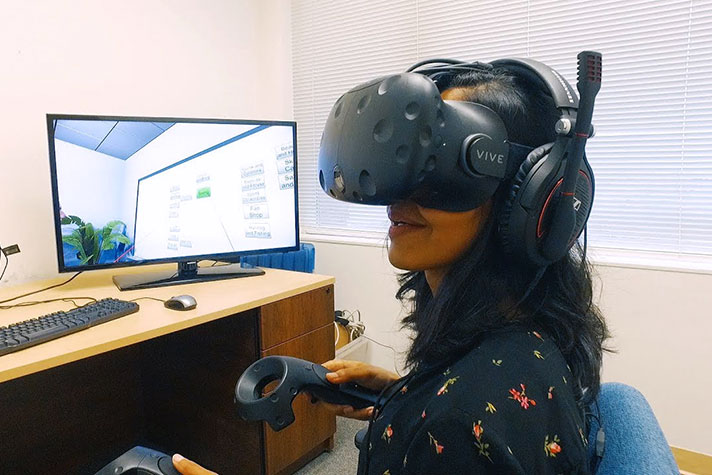
Software Applications
Research Permissions Management System
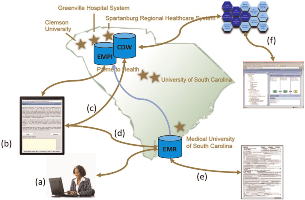 The Research Permissions Management System (RPMS) is a new and innovative solution developed from a grant from the National Library of Medicine at the National Institute of Health to address the challenges associated with collecting and managing informed consent and research permissions in clinical and research settings. The current paper-based methods are often time-consuming, difficult to manage, and prone to errors, leading to low patient trust and poor research participant recruitment. RPMS provides a comprehensive and electronic mechanism to capture and manage informed consent, research authorizations, and patient permissions in a centralized and secure manner. This system is designed to improve the efficiency, accuracy, and transparency of the informed consent and research authorization process, thereby enhancing patient trust and increasing research participant recruitment.
The Research Permissions Management System (RPMS) is a new and innovative solution developed from a grant from the National Library of Medicine at the National Institute of Health to address the challenges associated with collecting and managing informed consent and research permissions in clinical and research settings. The current paper-based methods are often time-consuming, difficult to manage, and prone to errors, leading to low patient trust and poor research participant recruitment. RPMS provides a comprehensive and electronic mechanism to capture and manage informed consent, research authorizations, and patient permissions in a centralized and secure manner. This system is designed to improve the efficiency, accuracy, and transparency of the informed consent and research authorization process, thereby enhancing patient trust and increasing research participant recruitment.
The RPMS software is available for download on GitHub.
Fuel Rod Inspection Simulator
 The Fuel Rod Inspection Simulator (FRINSim) is a training tool designed to teach nuclear material inspectors the skills required for visually inspecting fuel rods. In the nuclear industry, fuel rods contain nuclear fuel, which needs to be inspected regularly to ensure the safety and integrity of the fuel and the reactor. The objective of FRINSim is to provide a realistic and effective training environment for nuclear material inspectors to develop and refine their inspection skills. By using FRINSim, inspectors can practice detecting and analyzing defects in simulated fuel rods without the risk associated with inspecting actual fuel rods. The results of this training are expected to enhance the skills and confidence of nuclear material inspectors, leading to more accurate and consistent inspections and ensuring the safety of nuclear reactors.
The Fuel Rod Inspection Simulator (FRINSim) is a training tool designed to teach nuclear material inspectors the skills required for visually inspecting fuel rods. In the nuclear industry, fuel rods contain nuclear fuel, which needs to be inspected regularly to ensure the safety and integrity of the fuel and the reactor. The objective of FRINSim is to provide a realistic and effective training environment for nuclear material inspectors to develop and refine their inspection skills. By using FRINSim, inspectors can practice detecting and analyzing defects in simulated fuel rods without the risk associated with inspecting actual fuel rods. The results of this training are expected to enhance the skills and confidence of nuclear material inspectors, leading to more accurate and consistent inspections and ensuring the safety of nuclear reactors.
Simulators Built for Experimental Studies
Studies on human adaptation to latency in teleoperated multi-robot human-agent teams
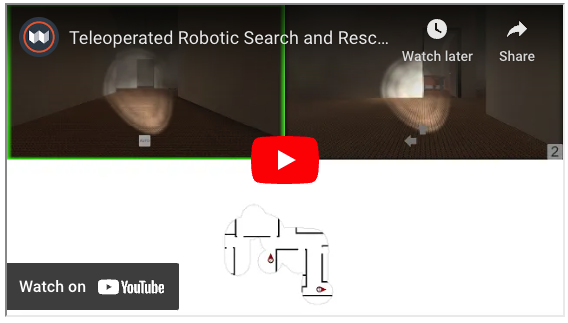 Teleoperated missions often involve communication delays, referred to as latency, which can significantly impact the system's performance, workload, trust, and usability. To better understand these impacts, this study investigates the effects of latency on a set of dependent variables. The dependent variables include performance, measured by both the time required to complete a task and the number of errors made, subjective workload, trust, and usability. The study was conducted using a simulated search-and-rescue mission, and the effects of latency were evaluated across two levels of two independent variables. The results of this study will provide valuable insights into the relationship between latency and various aspects of teleoperated mission performance and usability and can inform the design and optimization of teleoperated systems for multiple applications, such as search-and-rescue, space exploration, and military operations.
Teleoperated missions often involve communication delays, referred to as latency, which can significantly impact the system's performance, workload, trust, and usability. To better understand these impacts, this study investigates the effects of latency on a set of dependent variables. The dependent variables include performance, measured by both the time required to complete a task and the number of errors made, subjective workload, trust, and usability. The study was conducted using a simulated search-and-rescue mission, and the effects of latency were evaluated across two levels of two independent variables. The results of this study will provide valuable insights into the relationship between latency and various aspects of teleoperated mission performance and usability and can inform the design and optimization of teleoperated systems for multiple applications, such as search-and-rescue, space exploration, and military operations.
Interfaces to support the situation awareness of remotely operated vehicle (ROV) operators
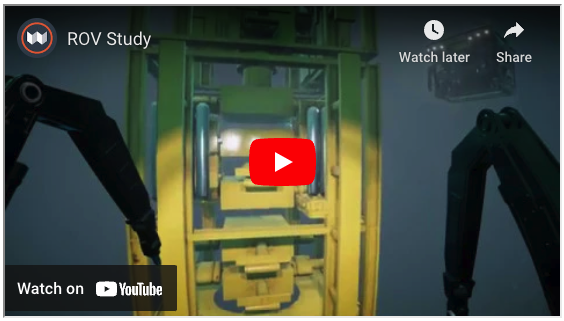 This project aims to advance the state of the art in remote underwater vehicle (ROV) operations by developing and evaluating interfaces that enhance situation awareness among ROV operators working as a team. Situation awareness refers to understanding the current state of an environment and is critical for effective and safe ROV operations, especially when multiple operators are involved. By building and testing these interfaces, this project aims to provide ROV operators with the information they need to make informed decisions, respond to unexpected events, and coordinate their actions with their team members. The results of this project will provide insights into the design of effective and usable interfaces for supporting situation awareness in ROV operations and will inform the development of advanced technologies that can improve the performance and safety of ROV operations.
This project aims to advance the state of the art in remote underwater vehicle (ROV) operations by developing and evaluating interfaces that enhance situation awareness among ROV operators working as a team. Situation awareness refers to understanding the current state of an environment and is critical for effective and safe ROV operations, especially when multiple operators are involved. By building and testing these interfaces, this project aims to provide ROV operators with the information they need to make informed decisions, respond to unexpected events, and coordinate their actions with their team members. The results of this project will provide insights into the design of effective and usable interfaces for supporting situation awareness in ROV operations and will inform the development of advanced technologies that can improve the performance and safety of ROV operations.
Immersive virtual reality environments for collaborative work
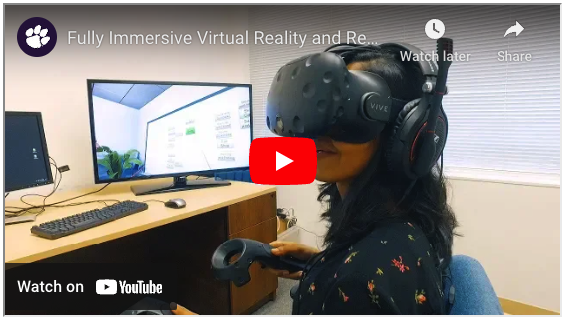 The integration of high-fidelity voice-based communication, immersive audio, and data-sharing tools into virtual reality environments has revolutionized the way collaborative work is performed. To further explore the benefits of these new technologies, virtual reality environments have been specifically designed to support collaborative work. Controlled experimental studies have been conducted to compare the effectiveness of immersive virtual reality-based settings for collaborative work compared to traditional methods. These studies aim to provide insights into how virtual reality environments can impact collaboration processes, such as communication, decision-making, and task performance. The results of these studies have the potential to inform the development and implementation of virtual reality-based solutions for collaborative work, leading to increased productivity, efficiency, and satisfaction among teams.
The integration of high-fidelity voice-based communication, immersive audio, and data-sharing tools into virtual reality environments has revolutionized the way collaborative work is performed. To further explore the benefits of these new technologies, virtual reality environments have been specifically designed to support collaborative work. Controlled experimental studies have been conducted to compare the effectiveness of immersive virtual reality-based settings for collaborative work compared to traditional methods. These studies aim to provide insights into how virtual reality environments can impact collaboration processes, such as communication, decision-making, and task performance. The results of these studies have the potential to inform the development and implementation of virtual reality-based solutions for collaborative work, leading to increased productivity, efficiency, and satisfaction among teams.
Virtual reality environments for empathy generation among informal caregivers of dementia patients
 Several studies have highlighted the importance of educating informal caregivers and the general public about the symptoms and behavioral changes associated with dementia. It is believed that acquiring this knowledge can increase feelings of competence and decrease psychological distress among these caregivers. To address this need, a collaborative virtual reality-based simulation has been developed in which informal caregivers take on the perspective of a person with dementia. This simulation mimics the visual impairments that often accompany conditions such as macular degeneration, cataracts, and glaucoma, thus providing caregivers with a more immersive and realistic understanding of what it is like to live with these conditions. Additionally, participants are provided with plastic ribbed shoe inserts that mimic the sensory handicaps that can occur with aging and dementia, further enhancing the overall simulation experience. By providing informal caregivers with a more immersive understanding of the experience of living with dementia, this virtual reality-based simulation has the potential to impact their knowledge, competence, and well-being significantly.
Several studies have highlighted the importance of educating informal caregivers and the general public about the symptoms and behavioral changes associated with dementia. It is believed that acquiring this knowledge can increase feelings of competence and decrease psychological distress among these caregivers. To address this need, a collaborative virtual reality-based simulation has been developed in which informal caregivers take on the perspective of a person with dementia. This simulation mimics the visual impairments that often accompany conditions such as macular degeneration, cataracts, and glaucoma, thus providing caregivers with a more immersive and realistic understanding of what it is like to live with these conditions. Additionally, participants are provided with plastic ribbed shoe inserts that mimic the sensory handicaps that can occur with aging and dementia, further enhancing the overall simulation experience. By providing informal caregivers with a more immersive understanding of the experience of living with dementia, this virtual reality-based simulation has the potential to impact their knowledge, competence, and well-being significantly.
Visualization strategies to support the situational awareness of windstorm risk engineers
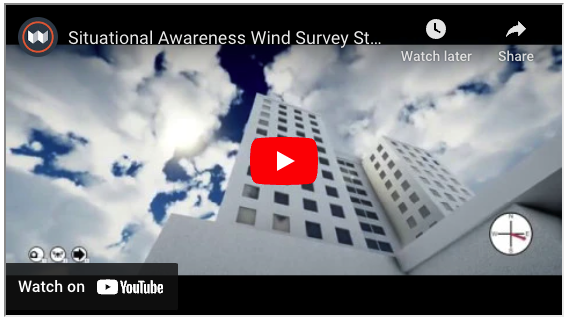 This simulation was designed to examine the impact of different context-based visualization strategies on the situational awareness and performance of windstorm risk engineers. The independent variable in the study is the type of context-based visualization used, which was manipulated at three levels: the absence of any visual aids, the use of a checklist-based visual aid, and the use of a predictive display-based visual aid. The purpose of the study is to explore how various context-based visualization strategies can support the situational awareness needs of windstorm risk engineers and impact their overall performance. The results of this study will provide valuable insights into the most effective methods for enhancing situational awareness in high-stakes and complex work environments and can inform the design and implementation of visualization tools in such settings.
This simulation was designed to examine the impact of different context-based visualization strategies on the situational awareness and performance of windstorm risk engineers. The independent variable in the study is the type of context-based visualization used, which was manipulated at three levels: the absence of any visual aids, the use of a checklist-based visual aid, and the use of a predictive display-based visual aid. The purpose of the study is to explore how various context-based visualization strategies can support the situational awareness needs of windstorm risk engineers and impact their overall performance. The results of this study will provide valuable insights into the most effective methods for enhancing situational awareness in high-stakes and complex work environments and can inform the design and implementation of visualization tools in such settings.
Virtual Reality Simulations for Training
Virtual reality environments for enhancing safety
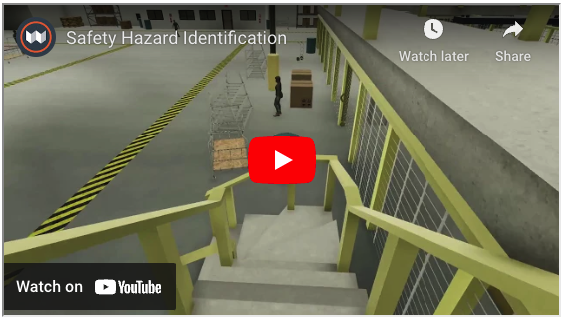 We present a virtual simulation created to educate students on identifying deficiencies in a manufacturing facility. The virtual world is experienced from a first-person perspective, allowing users to move through the environment using the keyboard and to observe their surroundings using the mouse. The virtual environment has been modeled after a car manufacturing assembly line, featuring realistic components such as robotic arms performing welding tasks, high storage racks, and forklift lanes. The simulation includes potential hazards that students must identify and address, such as oil spills, obstructed lanes/exit doors, and simulated fires. This virtual simulation provides students with a unique and engaging learning experience that enables them to apply their knowledge of hazard identification in a safe, controlled, and interactive environment.
We present a virtual simulation created to educate students on identifying deficiencies in a manufacturing facility. The virtual world is experienced from a first-person perspective, allowing users to move through the environment using the keyboard and to observe their surroundings using the mouse. The virtual environment has been modeled after a car manufacturing assembly line, featuring realistic components such as robotic arms performing welding tasks, high storage racks, and forklift lanes. The simulation includes potential hazards that students must identify and address, such as oil spills, obstructed lanes/exit doors, and simulated fires. This virtual simulation provides students with a unique and engaging learning experience that enables them to apply their knowledge of hazard identification in a safe, controlled, and interactive environment.
Virtual reality simulations to train field engineers
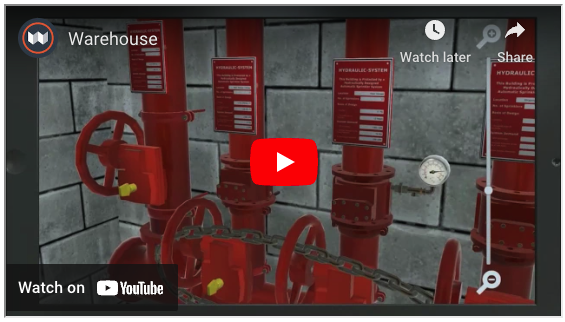 To provide hands-on training to risk engineers in the realm of hazard identification and safety, we have created a series of virtual reality (VR) simulations. The simulations, designed to be viewed from a first-person perspective, encompass a variety of environments, including a manufacturing plant, a warehouse, and an exterior walkthrough. The objective of the simulations is to challenge users to locate and document, through virtual photography, various safety violations they encounter in these settings. The VR simulations provide an innovative, immersive, and engaging way to impart the technical concepts related to hazard identification and safety to risk engineers.
To provide hands-on training to risk engineers in the realm of hazard identification and safety, we have created a series of virtual reality (VR) simulations. The simulations, designed to be viewed from a first-person perspective, encompass a variety of environments, including a manufacturing plant, a warehouse, and an exterior walkthrough. The objective of the simulations is to challenge users to locate and document, through virtual photography, various safety violations they encounter in these settings. The VR simulations provide an innovative, immersive, and engaging way to impart the technical concepts related to hazard identification and safety to risk engineers.
Exploring a Jet Engine – An activity for kindergarten students.
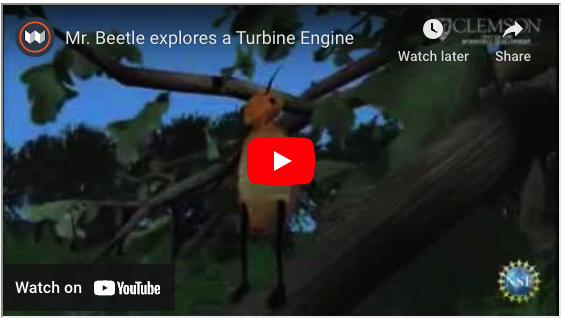 Jet engines move the airplane forward with a great force that is produced by a tremendous thrust and causes the plane to fly very fast. This simulation provides an overview of the working mechanism of a Jet Engine from a beetle’s perspective.
Jet engines move the airplane forward with a great force that is produced by a tremendous thrust and causes the plane to fly very fast. This simulation provides an overview of the working mechanism of a Jet Engine from a beetle’s perspective.
